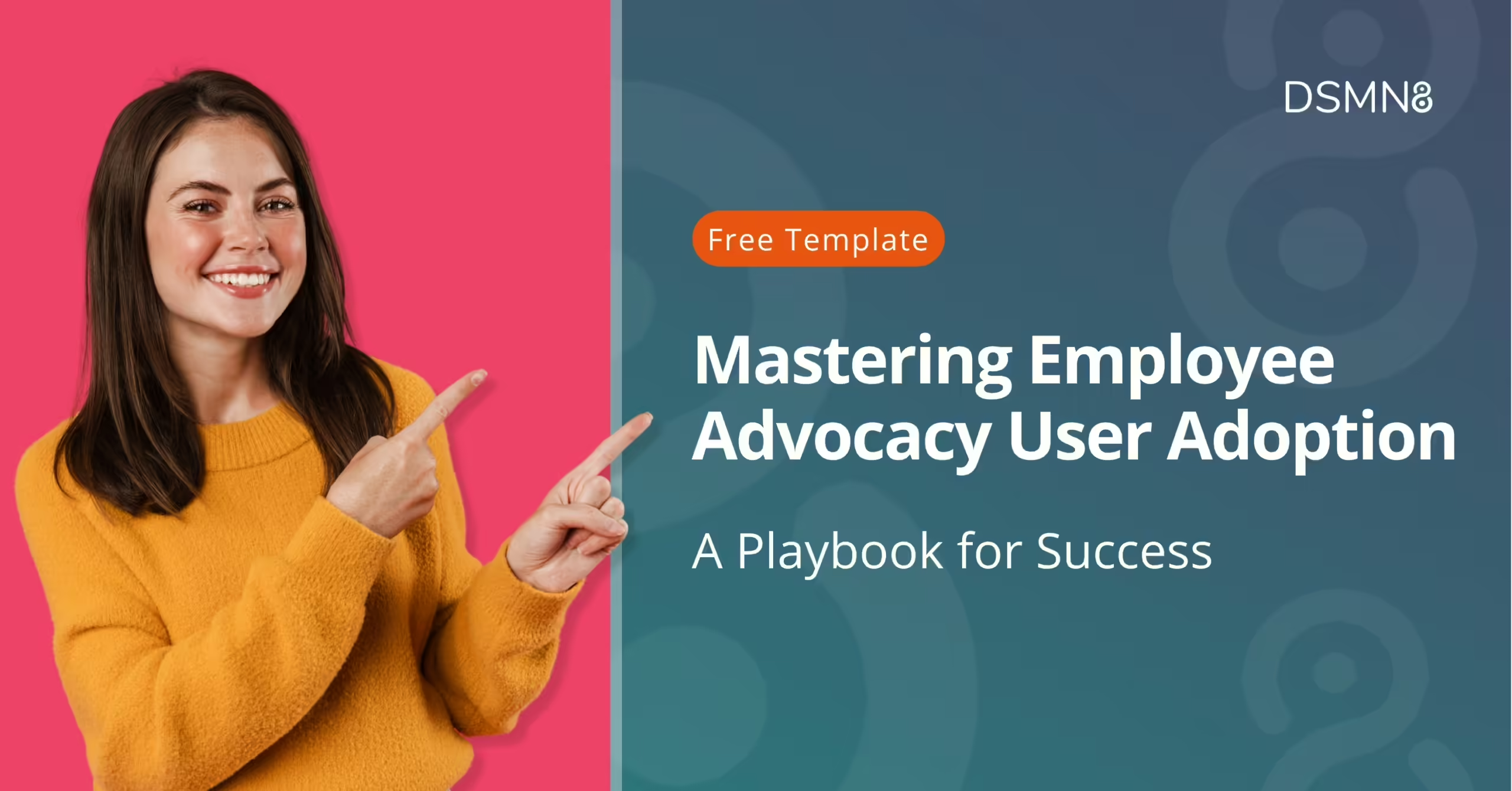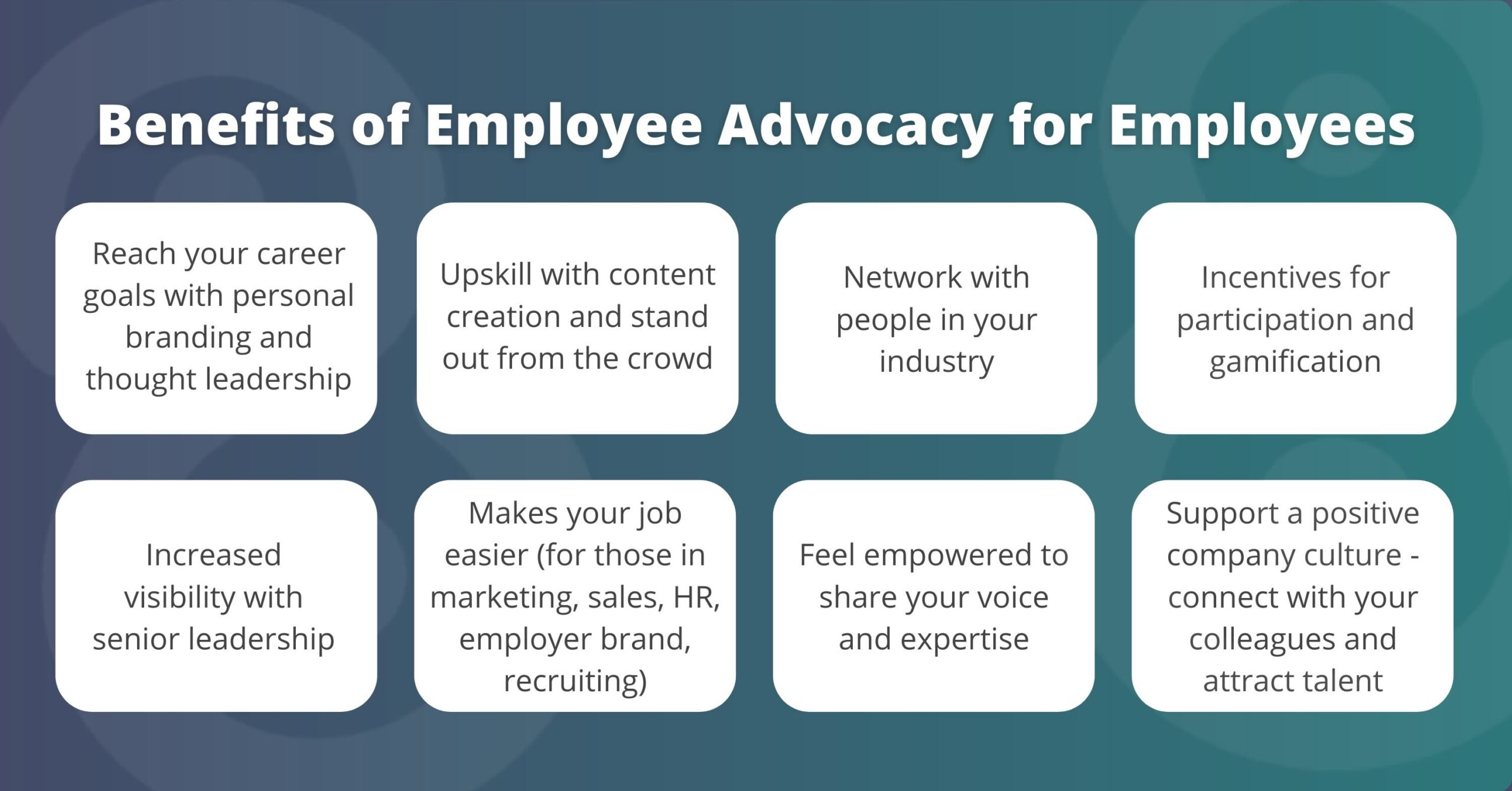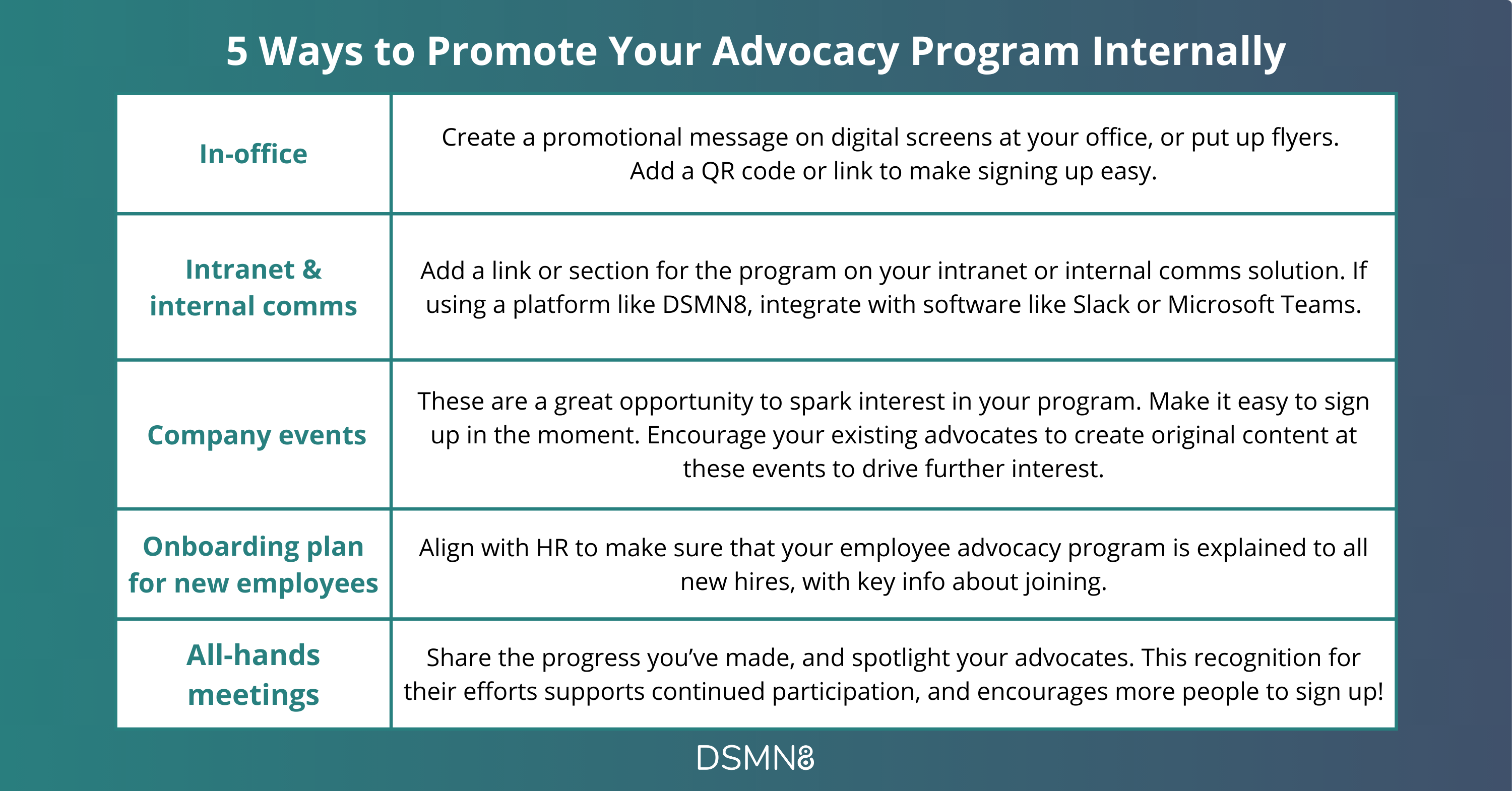
Whether you’re just launching an employee advocacy program or managing one already, user adoption should be on your mind.
You could have the best content in the world, but if your advocates aren’t engaged, or you’re struggling to get them on board in the first place…
Your program simply won’t be successful.
But fear not! Today we’re covering the key tactics and strategies for building and maintaining a community of engaged employee advocates.
This playbook is adapted from a guide created for DSMN8 clients, with insights from our customer success team. With years of experience supporting and scaling hundreds of employee advocacy programs, they really know their stuff!
We’ve created a PDF playbook split into 4 stages to help you attract and engage your team. At the end, you’ll find an onboarding timeline and printable worksheet to help plan your user adoption process.
Let’s get started 👇
Step 1: The Fundamentals
This first stage should ideally happen before inviting employees to join your program.
But if you’ve already launched your program, don’t panic! It’s not too late to get these fundamentals in place.
Discover Your Ideal Advocates
Ask yourself questions like “who will benefit the most from this initiative?” and “do we already have any influencers or thought leaders at our company?”.
Invite these individuals first as they will quickly recognize the advantages of joining. They are also more inclined to stay engaged and assist in spreading the word to others.
Our ideal advocate profiles worksheet and pyramid of employee influence will help you plan out who to approach.
Who Are Your Program Stakeholders?
Employee advocacy typically sits within marketing and communications teams. But advocacy has a huge potential impact for departments like sales, HR, and recruitment.
Having stakeholders in various departments in tandem with marketing is more likely to drive widespread adoption across your company.
You’ll establish a program with multiple team leaders who have a vested interest in success. Employees will be more inclined to participate if their direct managers ask them to. This also prevents employee advocacy being seen as ‘just marketing’.
Update Your Social Media Policy
Is your social media policy ready for employee advocacy? Or does it prohibit employees from creating and sharing content?
Many employees are eager to share content, but they’re afraid of getting in trouble for doing so. Alleviate this fear by ensuring that your social media policy encourages employees to get involved, provide reasonable guidelines and brand assets.
The crucial part is to make sure that every employee has access to these documents, not just your new starters.
Add a link to your social media policy to your internal comms platform or intranet. You could even send out a company-wide email to let everyone know about the changes.
Additional Resources for Step 1:
Step 2: Support & Training
Providing your advocates with resources and training goes a long way. It’ll support getting your team active on social media, alleviate any fears or risks, and encourage continued participation.
Investing in employee development shows that you believe in the program, and want to support their up-skilling and career progression.
First, you’ll need to understand the level your employees are currently at. It’s likely that you already have some social media pros amongst your ranks, and at the other end of the scale, some who don’t yet have LinkedIn profiles.
Use our social media survey template to find out which team members need ‘social media 101’ training, and others who would benefit more from a session on driving engagement on social or content creation best practices.
Keep in mind that support and training should continue as you scale your program. Recording any sessions will be useful for streamlining this process. Establish a communications channel for any questions or concerns that may come up.
Most importantly, employees need to know how advocacy benefits them. Framing your program as simply a way for your company to increase sales and generate brand awareness won’t inspire many to participate.
If you’re using an employee advocacy platform like DSMN8, be sure to provide training on how to use the tools provided. While DSMN8 is very user-friendly, we want to make sure your team are set up for success. For that reason, we offer an on-demand video training series to help get your team up-to-speed.
Additional Resources for Step 2:
Step 3: Spread the Word
Now it’s time to spread the word across your wider organization. The goal is to build a community around your program, making it part of your company culture.
Start by getting senior leadership involved. Aim for the CEO, or another C-suite executive for the best results. When employees see that the program is endorsed by senior leaders, they’ll be more motivated to take part.
The benefits of leadership participation go beyond encouraging user adoption. Increased visibility and engagement with the C-Suite helps employees establish positive professional relationships and feel more connected with your company culture.
Research by LinkedIn showed that people are 58% more likely to apply for a role if the CEO is active on social media.
Plus, our own study of 11,107 employee LinkedIn posts revealed that a CEO with 5,000 followers generated the same average engagement as their company page with 300,000 followers.
Additional Resources for Step 3:
Step 4: Re-Engage & Level Up
The final stage of the employee advocacy user adoption playbook is to re-engage inactive users and level up your program by taking a data-driven approach.
Remember that communications channel we mentioned in the training & support section? This is imperative for maintaining user engagement.
Use it to let your team know when there’s new content to share, gather feedback on the existing content, and find out what training sessions to provide next.
Make sure this communication isn’t one-sided. Employee advocates need to have their voices heard to build a community around the program.
Encourage original employee-generated content, celebrate successes, and take their ideas on board.
Bradley goes into more detail about the importance of creating a feedback loop for user adoption in this episode of the Employee Advocacy & Influence Podcast:
To find out how advocates feel about your program and gain insights to improve, send out our employee advocate feedback survey.
If you’re using a platform like DSMN8, analytics will reveal the content that resonates best with your advocates and their audiences. This enables you to take a data-driven approach to your content creation strategy and keep an eye on user engagement.
With our newsletter feature, you can send custom emails to your advocates, highlighting your most recent (or most important) pieces.
This is a great way to re-engage employees that may have been too busy to check out all of your latest content. Send newsletters to everyone in your program, or use our dynamic list functionality to focus on those less engaged.
Gamification is another great way to boost participation and entice dormant advocates to re-engage. DSMN8’s leaderboards gamify the experience to spark healthy competition among your team.
To take it further, you could offer prizes like company merch or charity donations. Running these initiatives periodically will motivate continued engagement as well as new signups.
Remember that forcing advocacy isn’t the way to success.
If an advocate is disengaged despite following all of the above, reach out and ask why! You might discover that they simply have too much on their plate at the moment.
Ultimately, there are always more potential advocates in your company, and active advocates who would benefit from more support.
Additional Resources for Step 4:
Get the Playbook
Fill out the form below to get the employee advocacy user adoption playbook PDF.
Emily Neal
SEO and Content Specialist at DSMN8. Emily has 10 years experience blogging, and is a pro at Pinterest Marketing, reaching 1 million monthly views. She’s all about empowering employees to grow their personal brands and become influencers.






